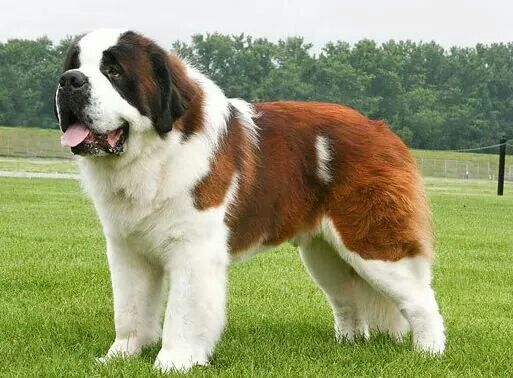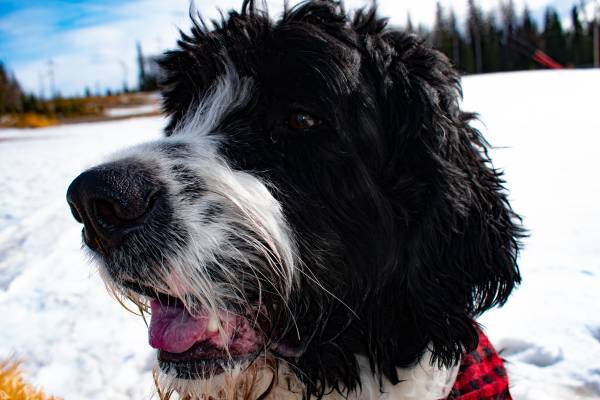Connect with a verified veterinarian in minutes. Licensed vets are available 24/7 to answer your questions. No need to worry about your furry family member.
Are you adopting a Saint Bernard? Then you’ve come to the right place! We’re going to take a look at these beautiful dogs, the breed made famous by Beethoven, the famous St. Bernard in the movies!
These loving, gentle giants are also famous for being tolerant, even with kids (who are well-behaved). They are trainable and eager to please, making them a great family dog. However, it’s also important to understand about the needs these dogs have when it comes to eating, their size and more.
St. Bernard: a Short History of the Breed
Many people associate these dogs with the Swiss Alps, and for good reason. These beautiful dogs do actually come from Switzerland, in an area near the Great St. Bernard Pass, which links Italy and Switzerland.
The history of the St. Bernard dog breed goes back to the late 1600s to this part of Switzerland, when they were used as watch dogs to go out and protect against marauders. The St. Bernard pass was a frequent pilgrimage route for those traveling to Rome. The dogs were also used as rescue dogs in the mountains.
In 1855, one of the dogs was sold to a Mr. Klopfenstein, who lived in Neuenegg. This man then sold the dog to Heinrich Schumacher that same year. The dog was named Barry I, and he became a stud dog for Schumacher’s kennel. By 1862, Schumacher began shipping the dogs to England, Russia and the U.S. Charles Grodin, Dean Jones, Bonnie Hunt and George Newton are all famous people who own a St. Bernard.
View this post on Instagram
What About the St. Bernards and their Kegs?
It appears the legend of these dogs wearing kegs actually started with a painting. It was called ‘Alpine Mastiffs Reanimating a Distressed Traveller’ by Sir Edwin Henry Landseer. The dog in the painting is wearing the famous keg.
The dogs didn’t really wear the barrels, though it is said that the dogs did wear packs filled with supplies for travelers who had lost their way.
What a great history these dogs have had! Now, let’s take a look at the St. Bernard dog as a breed!

Review symptoms, medications & behavior to keep your pets healthy with a Vet Online in just minutes.
Ask a Vet Live NowInformation about the St. Bernard Breed
While St. Bernards have been working dogs, today they’re considered family dogs who live in the house. Even so, pet parents do enter their St. Bernards in dog shows, weight pulling competitions and more. They are a part of the Mastiff family. The breed was first recognized by the AKC back in 1885.
These dogs are very powerful, muscular and can be somewhat intimidating due to their size. They have huge heads, with a short muzzle, and those beautiful deep brown eyes that just melt your heart. Along with being gentle giants. St. Bernards are also known for their intelligence and their friendly faces. Brian Levant, Christopher Castile, David Duchovny and Dr. Varnick are all famous St. Bernard owners who love this big pooch.
When it comes to their coat, they have two—they are both long- and short-haired. Their fur tends to be bushy and dense. St. Bernard’s coat comes in different colors including white with red, or red with white. The shade of red can vary. The white fur is usually found on the Beethoven dog’s chest, around the neck and nose, as well as on the feet and the tip of the tail. You may also see a white path on the back of their neck, with dark spots on the head and ears.
View this post on Instagram
Keep in mind that you may want to clear off the coffee table and other spots that your dog’s tail could brush up against. Everything in the space will go flying when your fur baby wags that huge tail! Sarah Rose Karr and Stanley Tucci have many quotes related to this dog breed specifically its unique barks.
While they can excel at some types of competitions, these dogs are only somewhat active. This is what makes them great house dogs, even if a home has a smaller yard. They are sensitive to high temperatures and so need to live where it’s cooler, or in an air-conditioned home. They do drool quite a bit.
Saint Bernards are loyal and protective of their families. They’re usually gentle around kids, though they may also be overly protective if they feel the children are threatened. While they love kids, it’s best to always supervise your kids and fur babies—never leave them unattended. Accidents can happen in the blink of an eye. Emily Newton, Missy or Oliver Platt are likely names you associated with this beautiful vernon color dog, Beethoven the dog never lost in popularity and is still today very commonly found in pet shops of large cities like New York.
The dog is considered a giant breed. Puppies can weigh about 25lbs, while adults tend to weigh between 120-180 lbs or more. The one sad thing to know about these loveable giants is that they have a short lifespan. St. Bernard dogs tend to live about 7 to 10 years, due to their large size.
St. Bernard Temperament
A properly socialized and trained St. Bernard is definitely gentle, calm and patient. While they are large and tend to scare strangers, they are not aggressive. Their size keeps robbers and others away with no problem!
These large dogs don’t need large yards to run in, in spite of their size. They are not as active as some other dog breeds. They do need exercise, though, and appreciate daily walks. While they’re not highly active, they do enjoy training, participating in dog sports (including cart pulling), etc. They also enjoy taking part in obedience trials and even tracking. St. Bernards are also sometimes used as therapy dogs.
In addition to adapting well to apartment living, these dogs also do well left alone during the day. However, they do need to be indoor dogs, as they love spending time with their family.
View this post on Instagram
Health & Beethoven Dogs
Beethoven dogs (St. Bernards) are usually very healthy; however, they have a tendency for certain health issues:
- Hip dysplasia
- Elbow dysplasia
- Entropion (a condition that causes the eyelid to roll inward)
- Epilepsy
- Cataracts
- Allergies
- Gastric dilatation-volvulus (GDV—also called bloat or torsion)
While Saint Bernards are known for their gentle nature and imposing size, it’s essential to be aware of their health, including common issues like sneezing. Learn more about why dogs keep sneezing to ensure your furry friend stays comfortable and healthy.
Even if you adopt a St. Bernard from a reputable breeder, there’s a chance your canine companion could suffer from these conditions. It is for these reasons, however, that make even imperative to get your dog from a good breeder. A reputable breeder will have health certifications that show the dog was tested and cleared of certain health conditions.
And if you decide to adopt your fur baby from a Saint Bernard rescue he could develop one of these medical conditions. That shouldn’t keep you from adopting him, but do be aware of these problems. They can result in expensive vet bills, so you may want to consider buying pet health insurance for your St. Bernard.
How to Care for a St. Bernard
As noted earlier, Beethoven dogs only requite a moderate amount of exercise. However, they still need regular exercise to avoid becoming obese. The additional weight can cause more stress on joints, leading to arthritis and other problems.
This dog breed doesn’t deal well with the heat; St. Bernards have a tendency to heat exhaustion and heatstroke. So, in the warmer months, be sure to exercise your fur baby in the cool of the day. That’s usually in the early morning. And make sure your pup has access to shade and fresh water when he’s outside. Never leave your Beethoven dog out for very long, as they don’t tolerate the heat. Plus, they long to be with their pet parents and family.
If you get a St. Bernard puppy, they will need obedience training and proper socialization. This way your puppy will know not to tear things up (your belongings, the furniture, and more), plus they will gain experience around other people and dogs. A puppy also benefits from new experiences. All of this will ensure your puppy is obedient, while also being friendly around others. Beethoven’s Christmas adventure and its characters Ryce, Ted, Harvey or Chris have made this dog breed a Hollywood star. Many people have also adopted a dog of this breed in memory of Ludwig Van Beethoven.
Because St. Bernards have such dense fur, they need to be brushed at least three times a week to avoid tangles and matts. They will need additional brushing during the shedding season, which is best done outside. Otherwise, you’ll have a pile of hair that’s enough to make another dog! For pet hair removal products, check out PetLovers.com.
When it comes to bathing, unless you have a large bathroom and bathtub, you may want to consider bathing your St. Bernard outside. A walk-in shower in the house is also another option.
St. Bernards and Kids
Saint Bernards are very patient with kids and are careful when around them. The only trouble might the dog’s size—he could accidentally knock over a young child. Even though these dogs are gently giants, never leave your kids and the dog alone. All dogs, not only St. Bernards, should never be left unattended with kids around. You never know what may make a dog angry—if a child pulls their tail, ears, etc.
When it comes to other pets, St. Bernards usually get along with them. However, they should never be left alone with small dogs, cats or other small animals. While the dogs don’t usually have a strong prey instinct, like any dog, they may become excited if a smaller animal runs away from them. Plus, the Beethoven dog may not realize he’s so much larger than his smaller companions. He could accidentally lay down or sit on a smaller playmate!
Beethoven’s 2nd Dog for Sale
When it comes to buying a St. Bernard, you’ll want to look for a reputable breeder. To find a good breeder check with your vet. They may know of a St. Bernard breeder in your area. In addition, check with friends and relatives, as well as work colleagues. In addition, you can check with the Saint Bernard Club of America, or a similar organization where you live.
When you meet a breeder, don’t be surprised if they ask questions about your experience with dogs, your family, and any other fur babies. This is the sign of a reputable breeder—they want to make sure their dog or puppy is going to a good home! Beethoven’s big break in the Beethoven’s 3rd, Beethoven’s 4th, Beethoven’s 5th movies of the series have made this breed very popular. The Beethoven film, the Newton family, John Hughes, Nicholle Tom and many other famous people like Alice Newton as well as box office movies have made this dog breed the popular choice we know today.
You’ll also want to ask for a tour of the kennels, and if you’re getting a puppy, you may ask to meet the parents. Be sure to ask the breeder for a health certificate, too, which will prove the puppy (and his parents) are free of issues such as eye problems, hip and elbow dysplasia, etc.
Beethoven dog breed puppies can cost anywhere from $900, all the way up to $10,000 for puppies that come from an excellent line. Saint Bernard dog price for a registered adult can cost from $1,500 on up.
We hope this article has provided some helpful information on St. Bernards. And we wish you all the best in finding a St. Bernard who will be your loving, giant companion in the coming years!
Connect with a verified veterinarian in minutes. Licensed vets are available 24/7 to answer your questions. No need to worry about your furry family member.

Kyoko
Kyoko is from a family of 3 and moved to New York with her parents and siblings when she was 13. Kyoko is fond of spending a great amount of time with pets, specifically her beagle Luna and cat Missy. Her boyfriend often complains that she spends too much time giving attention to their animals. Kyoko has written dozens of articles concerning pets and is aiming at owning a pet shop one day!
Review symptoms, medications & behavior to keep your pets healthy with a Vet Online in just minutes.
Ask a Vet Live Now




